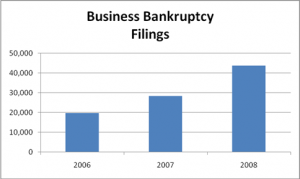|
|
|
Thursday, May 21st, 2009
“Is there a single devastating thing I may do unconsciously that messes my people up the most and, if so, what are the effects?”
I’ve heard variations of this question from many managers over the years.
The answer is yes, there sure is and if you aren’t doing it unconsciously then you’re one of the really bad guys and I can only hope that your turnover soars and your reputation spreads.
The action is inconsistency and the primary effect is fear. Secondary effects include intimidation and insecurity.
The end results in the business world are distrust, low productivity, less innovation, abysmal retention and, on a more personal level, poor reviews, fewer promotions and less opportunity.
It doesn’t matter that the inconsistency is unintentional, arbitrary or whimsical the results are the same.
It’s not knowing that really gets to people—even more than expected abuse.
Think about it. It’s one thing to have someone who constantly criticizes (unconstructively) or disparages you, because you can learn how to turn a deaf ear if, for some reason, you can’t get out of earshot. But when a zinger comes out of nowhere in what’s normally constructive, or at least neutral, feedback you’re caught unaware, thrown off balance and it really gets to you.
Actually, the more infrequent it is the worse it is when it does happen. And after it happens a few times people find themselves waiting for it, wondering when it’ll happen again and almost holding their breath to see if this is the time the other shoe will drop.
That fear grows exponentially once it takes root and distrust typically increases at the same rate.
Can you think of a worse scenario for people to labor under?
But when it’s unconscious, how do you know?
If you actually focus on the person with whom you’re talking, instead of checking your Blackberry or thinking about something else, you’ll see the zinger hit and you should be able to identify what it was. If you can’t, then ask! Acknowledge the reaction, state that you know it was something you said, but you’re not sure what. Be gentle if you expect the person to open up, but you stand a better chance if you ask immediately, while he’s still in shock.
 But if you did it on purpose to enjoy the show and then get them to open up so you can twist the knife, I sincerely hope that all your teeth and hair fall out and Zeus’ thunderbolt strikes you where you stand and chars you into tiny little bits. But if you did it on purpose to enjoy the show and then get them to open up so you can twist the knife, I sincerely hope that all your teeth and hair fall out and Zeus’ thunderbolt strikes you where you stand and chars you into tiny little bits.
Image credit: tdnb on sxc.hu
Posted in Business info, Motivation, Retention | 6 Comments »
Tuesday, May 19th, 2009
Possibly the most difficult question for any is business:
“Is it time to pull the plug?”
Business Bankruptcies up over 100% since 2006
In this difficult economic environment, many businesses are answering that question simply, “yes.” As the chart below shows, business bankruptcy filings grew dramatically in 2008, up over 100% from 19,695 in 2006 to 43,546 in 2008.

This chart is deceptive, because the average annual number of business bankruptcy filings for the 28 years 1980-2008 is 52,667 and the number of filings in 2005 was 39,201. So the 43,000 filings in 2008 are 20% below the long-term average and just a little above the number in 2005. But, regardless of the long-term average, the short-term trend is up over 200%.
Time to Pull the Plug on My Business?
Setting aside statistics, the question at hand is real, personal, and immediate for many small business owners. As a professional business consultant, I work with several clients struggling with this question.
One of my clients generates approximately $3,000,000 in revenue and supports 25 employees. For the past two years, this company’s revenue has remained flat, with annual losses of $250,000 or so. This year revenues have declined and the owner has kept the monthly losses to $20,000 by reducing expenses. So far, so good, right?
Will the situation improve in the near future? Is a turn-around in sight with just a little more patience and persistence? When does persistence become stubbornness? When is it time to pull the plug? How do you know? Forgive this barrage of questions—this is an extremely difficult, emotional question for a business owner.
What Are Your Choices?
As a business unit manager, you have the opportunity and responsibility to make major changes in your business. 2% solutions don’t count.
What few significant changes can you make to improve the problems facing your business?
- Eliminating People Means Eliminating Work. You simply cannot eliminate people and leave the workload unchanged. How can you reorganize your business to reduce the work? Can you automate or outsource back-office services or sales? Can you move more functions online? Can you move your customers to self-service online? Can you use online order / payment to simplify the sales and collection processes?
- Don’t Eliminate Products. Eliminate Production Costs. Can you shift inventory and fulfillment services to suppliers or third parties?
- Don’t Eliminate Value. Eliminate Overhead. Do you need all the office space, telephones, equipment, and software? Eliminate, reduce, or find it for free.
- Grow Revenues. Be careful here, as increasing revenue is extremely difficult, especially in this recession economy. It’s easy to forecast big growth, only to be surprised three months later when the growth has not appeared on schedule. First, find a few customers for your services, and then forecast the growth based on their orders.
You Already Know the Answer
Three business aphorisms provide some insights into this question:
- The universe rewards action.
- Ready, fire, aim.
- Follow the money.
Taken as a set, they offer a road map to making this difficult decision.
If your business is struggling, then do something! The business (universe) will respond to your actions.
If the business situation is getting worse, you have limited time and budget to make meaningful changes. This is not the time to be shy. Take some dramatic action. That’s the “ready, fire” advice. Observe the result. Based on the result, quickly adjust your actions to improve the outcome (aim).
Finally, follow the money to your desired outcome. You know your budget for time and money. When either one runs out, you lose your freedom of action. Take action now, while you still have freedom to choose.
The biggest obstacles to meaningful business change are usually not intellectual understanding of the problem, or a lack of options, but emotion and fear.
For instance, most business owners truly care for their employees so layoffs are difficult. “What will my employees do without this job? How will they survive?” If you are considering major changes in business direction, fear raises similar questions about you; “How will my company survive if I make this change? What will I do with my life if my company fails, or if I have to shut it down?”
Together, emotional attachment and fear of the future create a paralysis, even in the face of clear impending disaster. When you wake up at 2 AM, what is on your mind? If you can get past the emotion and fear, I believe you already know the answer. “Don’t go wobbly,” as Margaret Thatcher famously advised George Bush senior when he was preparing for the first Iraq war. “I just don’t know,” is a cop-out.
What is Your Biggest Fear?
If your company is losing money each month, you must make changes. In this economy, your business will not get better by itself. What is the single change you fear the most?
Turn off the computer, put down the cell phone. Be still for a few moments, sitting with your fears and emotions. What is your biggest fear? Go there. Do it.
Wishing you the courage to make the difficult decisions,

Posted in Strategy | No Comments »
Tuesday, June 17th, 2008
Image credit: bob923
 In April David Kirkpatrick, a Fortune senior editor, wrote about what it takes for adults to find value in Facebook; less than two months later comes a story about how recently hired Serena Software CEO Jeremy Burton is using Facebook to change the company’s corporate culture. In April David Kirkpatrick, a Fortune senior editor, wrote about what it takes for adults to find value in Facebook; less than two months later comes a story about how recently hired Serena Software CEO Jeremy Burton is using Facebook to change the company’s corporate culture.
Serena isn’t a hot growth company, but a profitable 25-year-old company building mainframe software and Burton isn’t a kick-ass Millennial, but rather a 40-year-old veteran of Oracle and Veritas, who says “We’ve got to be relevant to the future. So we instituted Facebook Friday,” and dared his people to participate and learn about each other—to date all 800 of Serena’s 900 employees have accounts. But the real message was “Guys – the world is a different place and if we’re going to stay relevant we’re going to have to wake up.”
He’s also using it to evangelize the software-as-a-service business model he believes is necessary for the company to thrive in the future.
Burton says, “I think we gain rather than lose productivity this way. We have a theme, but I leave it up to them to choose what to do.”
Millennials and many Web 2.0 proponents believe that the most important thing is to incorporate the technology because it’s there, but, as Burton shows, it works better to bring it in with a specific goal in mind. He understands that people worry about, and often fear, change, so wrapping change in a palatable way works faster.
The great lesson to take away from this isn’t about Facebook; it’s a reminder that “a spoonful of sugar makes the medicine go down.”
Do you think that sugar-coating change is good or bad?
Posted in Business info, Communication, Culture, Leadership | 2 Comments »
Friday, May 9th, 2008
Image credit: Sam UL
Yesterday, I wondered if the adoption of social media tools would parallel the spread, or lack thereof, of telecommuting and asked, “Is the problem truly generational? Age-related? A function of company size? Corporate culture?”
I believe that fear is the underlying, driving force behind not being willing to share, which, in turn, is the number one barrier to widespread use of social media tools.
People who fear often seek an antidote that doesn’t require them to change.
They see the antidote as power.
The source of power is control.
The only things worth controlling are money and information.
Money speaks for itself, whereas people at all levels, not just managers, alleviate their fear by finding ways to control the flow of information and they do this with little personal effort and at no perceived cost to themselves.
 But fear is like a cancer in MAP (mindset, attitude, philosophy™) and will continue to grow unless addressed directly. But fear is like a cancer in MAP (mindset, attitude, philosophy™) and will continue to grow unless addressed directly.
It may seem more difficult to make changes to your MAP, but the end result of changing it is far more valuable and lasting then the short-term fix offered by power—which is ethereal at best and imaginary at worst.
I can help if you or someone you know is dealing with fear and wants a lasting solution, feel free to call me at 866.265.7267
Posted in Communication, Culture, Retention | No Comments »
Monday, October 8th, 2007
There is one question I’m constantly asked.
The question, in one form or another, is this: Is there a single devastating thing I may be unconsciously doing that messes my people up the most and, if so, what are the effects?
Yup, there sure is, and if you aren’t doing it unconsciously then you’re one of the really bad guys and I can only hope that your turnover soars and your reputation spreads.
The action is inconsistency and the primary effect is fear. Secondary effects include intimidation and insecurity.
The end results in the business world are distrust, low productivity, less innovation, abysmal retention and, on a more personal level, poor reviews, fewer promotions and less opportunity.
It doesn’t matter that the inconsistency is unintentional, or whether it’s arbitrary or whimsical, the results are the same. It’s not knowing that really gets to people—even more than expected abuse.
Think about it. It’s one thing to have someone who constantly criticizes (unconstructively) or disparages you, because you can learn how to turn a deaf ear if, for some reason, you can’t actually get out of earshot. But when a zinger comes out of nowhere in what’s normally constructive, or at least neutral, feedback you’re caught unaware, thrown off balance and it really gets to you.
Actually, the more infrequent it is the worse it is when it does happen. And after it happens a few times people find themselves waiting for it, wondering when it’ll happen again, almost holding their breath to see if this is the time that the other shoe will drop. That fear grows exponentially once it takes root and distrust typically increases at the same rate.
Can you think of a worse scenario for people to labor under?
When it’s unconscious, how do you know? If you actually focus on the person with whom you’re talking, instead of checking your Blackberry or thinking about something else, you’ll see the zinger hit and you should be able to identify what it was. If you can’t, then ask! Acknowledge the reaction, state that you know it was something you said, but you’re not sure what. Be gentle if you expect the person to open up, but you stand a better chance if you ask immediately, while he’s still in shock.
But if you did it on purpose to enjoy the show and then get them to open up so you can twist the knife, I sincerely hope that all your teeth and hair fall out and Zeus’ thunderbolt strikes you where you stand and chars you into tiny little bits.
Posted in What Leaders DO | 2 Comments »
|
 Subscribe to
Subscribe to
MAPping Company Success
About Miki 
Clarify your exec summary, website, etc.
Have a quick question or just want to chat? Feel free to write or call me at 360.335.8054
The 12 Ingredients of a Fillable Req
CheatSheet for InterviewERS
CheatSheet for InterviewEEs™
Give your mind a rest. Here are 4 quick ways to get rid of kinks, break a logjam or juice your creativity!
Creative mousing
Bubblewrap!
Animal innovation
Brain teaser
The latest disaster is here at home; donate to the East Coast recovery efforts now!
Text REDCROSS to 90999 to make a $10 donation or call 00.733.2767. $10 really really does make a difference and you'll never miss it.
And always donate what you can whenever you can
The following accept cash and in-kind donations: Doctors Without Borders, UNICEF, Red Cross, World Food Program, Save the Children
*/
?>About Miki
About KG
Clarify your exec summary, website, marketing collateral, etc.
Have a question or just want to chat @ no cost? Feel free to write
Download useful assistance now.
Entrepreneurs face difficulties that are hard for most people to imagine, let alone understand. You can find anonymous help and connections that do understand at 7 cups of tea.
Crises never end.
$10 really does make a difference and you’ll never miss it,
while $10 a month has exponential power.
Always donate what you can whenever you can.
The following accept cash and in-kind donations:
|
 But if you did it on purpose to enjoy the show and then get them to open up so you can twist the knife, I sincerely hope that all your teeth and hair fall out and Zeus’ thunderbolt strikes you where you stand and chars you into tiny little bits.
But if you did it on purpose to enjoy the show and then get them to open up so you can twist the knife, I sincerely hope that all your teeth and hair fall out and Zeus’ thunderbolt strikes you where you stand and chars you into tiny little bits.





 In April David Kirkpatrick, a Fortune senior editor, wrote about
In April David Kirkpatrick, a Fortune senior editor, wrote about  But fear is like a cancer in
But fear is like a cancer in 
